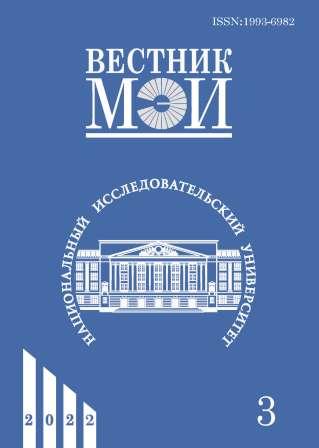The Influence of Renewable Energy Sources and Electric Energy Storages on Grid Power Balances
Abstract
In recent decades, increasingly more attention has been paid in our country and abroad to the use of renewable energy sources (RES). However, such factors as nonuniform distribution of RESs over the country territory and stochastic nature of their availability in time impede their wide-scale application. For RESs to be used on a wider scale, relevant regulatory and technical documents stipulating the electric power system designing should be developed, and a number of technical problems should be solved, e.g., those relating to the need of smoothing the electricity generation nonuniformity.
In this study, distribution power grids containing RESs (wind and solar power plants) and electric energy storages are considered. The aim of the study is to develop proposals for a procedure of integrating RESs and energy storages into grids. The study results are supposed to be used in developing software and hardware solutions for control of an energy storage and predict the electricity consumption and electricity generation by RESs in power grids.
In the study, mathematical modeling (computation experiment) methods were used for development of energy storage and RES models that take into account climatic factors (wind velocity, solar irradiance, and temperature) in certain geographical locations received from open data bases.
For studying the grid power balance reliability, the operation of RESs within a generalized distribution grid is considered. The grid contains an equivalent centralized power system source, a distribution network, consumer loads, various types of RESs (wind and solar power plants), and a centralized electric energy storage. The power outputs produced by wind and solar power plants for a day (based on hourly averaged meteorological conditions) and month are analyzed for a number of regions in Russia; the annual amount of electricity generated by them is estimated, and the effect of smoothing the generation schedules due to combination of various types of RES and use of electric energy storages is evaluated.
Universal models of RESs and electric energy storages for electric grid load flow analysis are suggested; the application of the developed models for power balance analysis of grids containing RESs and energy storages is illustrated; the key stages of introducing RESs and energy storage devices are identified and described, and tasks for which electrical operation modes have to be numerically analyzed are formulated.
References
2. Распоряжение Правительства РФ № 1523-р от 9 июня 2020 г. Об Энергетической стратегии РФ на период до 2035 г.
3. Gilbert M. Masters. Renewable and Efficient Electric Power Systems. New Jersey: Wiley, 2013.
4. Bellini A., Bifaretti S., Iacovone V., Cornaro C. Simplified Model of a Photovoltaic Module // Proc. Appl. Electronics Conf. 2009. Pp. 47—51.
5. Янсон Р.А. Ветроустановки. М.: Изд-во МГТУ им. Н.Э. Баумана, 2007.
6. Miller N.W., Price W.W., Sanchez-Gasca J.J. Dynamic Modeling of GE 1.5 and 3.6 Wind Turbine-Generators for Stability Simulations. NY: GE-Power Systems Energy Consulting, 2003.
7. Ретроспективные данные по климатическим параметрам [Электрон. ресурс] www.wunderground.com/history/ (дата обращения 18.06.2021).
8. Ретроспективные данные по климатическим параметрам географических мест [Электрон. ресурс] www.power.larc.nasa.gov/data-access-viewer/ (дата обращения 16.06.2021).
---
Для цитирования: Волошин Е.А., Онисова О.А., Наволочный А.А. Исследование балансов мощности при внедрении возобновляемых источников энергии и накопителей электрической энергии в электрическую сеть // Вестник МЭИ. 2022. № 3. С. 11—22. DOI: 10.24160/1993-6982-2022-3-11-22.
---
Работа выполнена при поддержке: Центра НТИ «Технологии транспортировки электроэнергии и распределенных интеллектуальных энергосистем» (Грант № 0000000007518Р240002)
#
1. Renewable Capacity Highlights. International Renewable Energy Agency [Elektron. Resurs] www.irena.org/-/media/Files/IRENA/Agency/Publication/2021/Apr/IRENA_-RE_Capacity_Highlights_2021.pdf?la=en&hash=1E133689564BC40C2392E85026F71A0D7A9C0B91 (Data Obrashcheniya 25.05.2021).
2. Rasporyazhenie Pravitel'stva RF № 1523-r ot 9 Iyunya 2020 g. Ob Energeticheskoy Strategii RF na Period do 2035 g. (in Russian).
3. Gilbert M. Masters. Renewable and Efficient Electric Power Systems. New Jersey: Wiley, 2013.
4. Bellini A., Bifaretti S., Iacovone V., Cornaro C. Simplified Model of a Photovoltaic Module. Proc. Appl. Electronics Conf. 2009:47—51.
5. Yanson R.A. Vetroustanovki. M.: Izd-vo MGTU im. N.E. Baumana, 2007. (in Russian).
6. Miller N.W., Price W.W., Sanchez-Gasca J.J. Dynamic Modeling of GE 1.5 and 3.6 Wind Turbine-Generators for Stability Simulations. NY: GE-Power Systems Energy Consulting, 2003.
7. Retrospektivnye Dannye po Klimaticheskim Parametram [Elektron. Resurs] www.wunderground.com/history/ (Data Obrashcheniya 18.06.2021).
8. Retrospektivnye Dannye po Klimaticheskim Parametram Geograficheskikh Mest [Elektron. Resurs] www.power.larc.nasa.gov/data-access-viewer/ (Data Obrashcheniya 16.06.2021).
---
For citation: Voloshin E.A., Onisova O.A., Navolochnyi A.A. The Influence of Renewable Energy Sources and Electric Energy Storages on Grid Power Balances. Bulletin of MPEI. 2022;3:11—22. (in Russian). DOI: 10.24160/1993-6982-2022-3-11-22.
---
The work is executed at support: NTI Center «Technologies of Electric Power Transportation and Distributed Intelligent Power Systems» (Grant No. 0000000007518Р240002)




